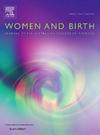Intrapartum hydration assessment and management: A cross-sectional survey of Australian and New Zealand maternity units
IF 4.4
2区 医学
Q1 NURSING
引用次数: 0
Abstract
Background
Hydration assessment and management during labour play an important role in maternal and newborn outcomes. Studies indicate that clinical practice is inconsistent, with limited consensus evident in clinical guidelines. Current practices in fluid management across public and private maternity units within Australia and New Zealand remain unknown. Respondents highlighted the importance of maternal hydration assessment and management to well-being. However, inconsistencies were noted in the documentation, medication use and adherence to clinical protocols.
Aim
Our study aimed to investigate unit-level clinical practice regarding intrapartum hydration assessment and management across Australian and New Zealand private and public hospitals. The scope of this study focuses on fluid management during both spontaneous and induced labour.
Method
We conducted a cross-sectional, descriptive survey to assess the fluid management practices of Australian and New Zealand maternity services.
Results
Of the 307 eligible maternity units, 89 participated (responding key informants included midwives, obstetricians, managers, and educators). All acknowledged the importance of maternal intrapartum hydration assessment and management. However, variations existed in assessment methods, with urine colour (87.6 %, n = 78) and frequency (84.3 %, n = 75), as well as maternal and fetal vital sign assessments (83.1 %, n = 74) being most prevalent. Documentation format and tools varied, and midwives identified this as their role. Despite the significance attributed to hydration by clinicians, not all felt confident in their capabilities to assess or manage intrapartum hydration. Free-text responses emphasised the significance of this topic from an educational perspective.
Conclusion
Respondents highlighted the significance of maternal intrapartum hydration assessment and maternal and newborn well-being management. However, inconsistent documentation, medication usage, including intravenous fluids, and clinical protocols were evident.
产时补水评估和管理:澳大利亚和新西兰产科单位的横断面调查。
背景:产程中的水分评估和管理在孕产妇和新生儿结局中起着重要作用。研究表明临床实践是不一致的,在临床指南中有有限的共识。目前,澳大利亚和新西兰公立和私立妇产单位的流动管理做法尚不清楚。答复者强调了产妇水合作用评估和管理对健康的重要性。然而,在文件、药物使用和对临床方案的依从性方面注意到不一致。目的:本研究旨在调查澳大利亚和新西兰私立和公立医院在分娩时水合作用评估和管理方面的单位临床实践。本研究的范围侧重于自然分娩和引产期间的液体管理。方法:我们进行了一项横断面描述性调查,以评估澳大利亚和新西兰产科服务的流体管理实践。结果:在307个符合条件的产科单位中,有89个参与了调查(回答的关键信息提供者包括助产士、产科医生、管理人员和教育工作者)。所有人都承认产妇产时水分评估和管理的重要性。在评估方法,然而,也存在与尿颜色(87.6 % n = 78)和频率(84.3 % n = 75),以及孕产妇和胎儿的生命体征评估(83.1 % n = 74)是最流行的。文件格式和工具各不相同,助产士认为这是她们的角色。尽管临床医生认为水合作用很重要,但并非所有人都对自己评估或管理产时水合作用的能力充满信心。自由文本的回答从教育的角度强调了这一主题的重要性。结论:受访者强调了产妇产时水分评估和母婴健康管理的重要性。然而,文件、药物使用(包括静脉输液)和临床方案明显不一致。
本文章由计算机程序翻译,如有差异,请以英文原文为准。
求助全文
约1分钟内获得全文
求助全文
来源期刊

Women and Birth
NURSING-OBSTETRICS & GYNECOLOGY
CiteScore
7.20
自引率
13.20%
发文量
371
审稿时长
27 days
期刊介绍:
Women and Birth is the official journal of the Australian College of Midwives (ACM). It is a midwifery journal that publishes on all matters that affect women and birth, from pre-conceptual counselling, through pregnancy, birth, and the first six weeks postnatal. All papers accepted will draw from and contribute to the relevant contemporary research, policy and/or theoretical literature. We seek research papers, quality assurances papers (with ethical approval) discussion papers, clinical practice papers, case studies and original literature reviews.
Our women-centred focus is inclusive of the family, fetus and newborn, both well and sick, and covers both healthy and complex pregnancies and births. The journal seeks papers that take a woman-centred focus on maternity services, epidemiology, primary health care, reproductive psycho/physiology, midwifery practice, theory, research, education, management and leadership. We also seek relevant papers on maternal mental health and neonatal well-being, natural and complementary therapies, local, national and international policy, management, politics, economics and societal and cultural issues as they affect childbearing women and their families. Topics may include, where appropriate, neonatal care, child and family health, women’s health, related to pregnancy, birth and the postpartum, including lactation. Interprofessional papers relevant to midwifery are welcome. Articles are double blind peer-reviewed, primarily by experts in the field of the submitted work.
 求助内容:
求助内容: 应助结果提醒方式:
应助结果提醒方式:


